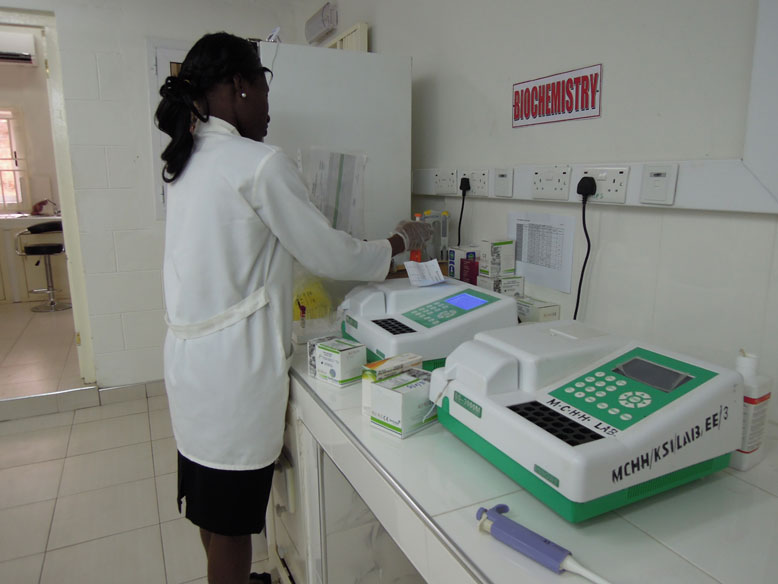¿Para qué sirve un laboratorio de diagnóstico clínico?
¿Para qué sirve un laboratorio de diagnóstico clínico?
August 21, 2014
¿Habéis pensado alguna vez cómo trabaja un equipo médico para llegar a diagnosticar una enfermedad? ¿Cómo se toman las decisiones para decidir el tipo de tratamiento a administrar a un paciente? Y ¿cómo se las apañan en las zonas más desfavorecidas del mundo para poder diagnosticar y tratar enfermedades?
El laboratorio clínico: ¿para qué sirve?
La clave es el laboratorio de diagnóstico clínico, un espacio donde se concentran los equipos e instrumentos necesarios para realizar la extracción, procesamiento y análisis de las muestras biológicas para confirmar un diagnóstico. El laboratorio de diagnóstico clínico es una herramienta primordial para los equipos médicos, ya que es el laboratorio el que se encarga de diagnosticar diferentes patologías y realizar los estudios necesarios para establecer el tratamiento a administrar y el posterior seguimiento clínico del paciente.
A principios del siglo XX, el médico raras veces acudía a los servicios del laboratorio para diagnosticar enfermedades. A mediados de siglo, y gracias a los avances de las técnicas médicas, quedó patente la necesidad de crear un servicio de laboratorio tal y como lo entendemos hoy en día.
Actualmente, el médico sigue interpretando los resultados de los análisis que obtiene del laboratorio y que posibilitan el diagnóstico, seguimiento y tratamiento de las enfermedades.
El laboratorio clínico en zonas desfavorecidas
En aquellos países en vías de desarrollo, o infradesarrollados, un laboratorio de diagnóstico clínico generalmente queda reducido a una pequeña habitación en la que se realizan los análisis clínicos más sencillos y urgentes. Aun así, cualquier pequeño espacio que haga la función de laboratorio puede ser esencial para la prevención y control de epidemias de enfermedades transmisibles, como es el caso del Virus de la Inmunodeficiencia Humana (VIH), la tuberculosis, el paludismo, el dengue o la fiebre amarilla, entre otras.
Entidades como la Fundación Probitas son conscientes de la vital importancia de mejorar las infraestructuras de los laboratorios de diagnóstico clínico en estas zonas. Algunas intervenciones que se realizan, a través de diferentes programas, son la mejora de las instalaciones, la redistribución de espacios, el suministro de agua potable, o la formación del personal de laboratorio local sobre gestión del laboratorio, manipulación y conservación de muestras biológicas, e interpretación clínica de los resultados obtenidos.
Probitas y algunos ejemplos del programa GLI: un refuerzo delos laboratorios básicos de diagnóstico de Ghana y Ecuador
A través del programa propio Global Laboratory Initiative (GLI), la Fundación Probitas tiene en funcionamiento cinco proyectos con el objetivo de reforzar laboratorios básicos de diagnóstico clínico en las regiones más vulnerables del planeta. El programa GLI actúa a través de la rehabilitación de espacios e infraestructuras básicas, la dotación de equipos analíticos de laboratorio, la formación de personal local, y el refuerzo de la capacidad resolutiva y la gestión de laboratorios.
Después de una primera experiencia piloto en Bamako, la Fundación trabaja actualmente en la mejora del laboratorio clínico del Maternal and Child Health Hospital,localizado en la ciudad de Kumasi, en el centro-sud de Ghana.
El objetivo es mejorar el servicio de diagnóstico clínico, optimizando el manejo de las patologías más prevalentes y los embarazos de riesgo; este hospital materno-infantil es el único centro especializado de la región en la prevención y tratamiento de la malnutrición infantil.
El tercer proyecto GLI, GLI-Ecuador, se está impulsando juntamente con ACNUR / UNHCR en el Hospital General de la Província Marco Vinicio Iza, Lago Agrio (Sucumbíos, Ecuador) y en el subcentro de Salud de Puerto del Carmen, en una zona de difícil acceso y con un desarrollo socio-económico reducido. Una situación de vulnerabilidad que empeora por el hecho de ser una población receptora de refugiados que huyen del conflicto armado de Colombia. El objetivo diseñado por ACNUR / UNHCR y Probitas consiste en cubrir las necesidades sociales y sanitarias básicas de la población local y refugiada mediante la ampliación y mejora de los servicios sociales y de salud, mejorando la capacidad de diagnóstico de las infecciones de transmisión sexual, entre las que destaca el VIH/SIDA, dada su alta prevalencia en la región.

